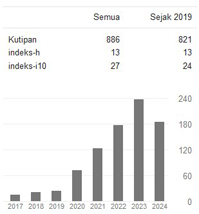MENYOAL IDENTITAS PEREMPUAN Analisa Identitas Sosial Perempuan Sirofenisia Dalam Mrk 7:24-30
Abstract
Abstract: Every narrative in the Bible has not only theological insight but also social-communal aspect. Thus, the biblical narrative contains inspiration for today's social life. One such narrative is the story of the Syrophoenician woman in Mark 7:24-30. This article studies the identity of Syrophoenician woman in the light of Social Identity Theory. This research is important because it is not common to investigate the identity of women with scientific social theory in the narrative of the Bible. By this research, we get an explanation of the identity of the Syrophoenician woman and her struggles as a woman and the mother of a daughter who is possessed by a demon. Syrophoenician woman is regainner respectable identity, namely domestic (family) affairs. Moreover, she has also gives an example for other women to be brave crossing geographical, political, cultural, and ethnic boundaries for salvation.
Key words Syrophoenician Woman, Social Identity Theory, Jewish, Mediterranian, Social Identity
Full Text:
PDFReferences
Aaron Kuecker, Ethnicity and Social Identity, dalam dalam J. Brian Tuckcer and Coleman A. Baker (ed),
T&T Clark Handbook to Social Identity in the New Testament, London: Bloomsbury Publishing, 2014.
Alan H Cadwallader, “When A Woman is a dog: Ancient and Modern Ethology Meet the Syrophoenician
women”, The Bible and Critical Theory, Vol 1. No.4, (2005).
Bernard C. Rosen, “Review: Human Groups and Social Categories: Studies in Social Psychology by
Henri Tajfel”, American Journal of Sociology, Vol. 90 No.1 (Jul 1984).
Ben Witherington III, Women in the Ministry of Jesus, New York: Cambridge University Press,1984.
Coleman A Baker, “Social Identity Theory and Biblical Interpretation” Biblical Theology Bulletin:
Journal of Bible and Culture, (Juni 2012).
Elisabeth T. Vasko, The Syro-Phoenician Woman: Disrupting Christological Compllacency dalam Beyond Apathy, Fortress Press, 2015.
Elliot Aronson dkk, Social Psychology (Ninth Edition), Boston: Pearson Education, 2013.
Erich S. Gruen, “Kinship Relations and Jewish Identity” dalam The Construct of Identity in Hellenistic
Judaism. Diakses pada 7 Mei 2021.
Eric K Wefald, “The Separate Gentile Mission in Mark: A Narrative Explanation of Markan Geography, the Two Feeding Accounts and Exorcisms”, Journal for the Study of the New Testament 60 (1995).
Fergus Millar, “The Phoenician Cities: A Case-Study of Hellenisation” Preceedings of the Cambridge
Philological Society, No.29 New Series (1983).
Francis Dufton, “The Syrophoenician Woman and her Dogs” The Expository Times (1989).
Geoffrey W. Bromiley, Theological Dictionary of the New Testament (edited by Gerhard Kittel and Gerhard Friedrich)-Abridged in one Volume, Grand Rapids: William B. Eerdmans Publishing Company, 1985.
H. Haag, Kamus Alkitab, Ende: Penerbit Nusa Indah, 1980.
Henri Tajfel, “Cognitive Aspects of Prejudice”, Journal of Biosocial Science Vol 1, (Januari 1969).
Howard Giles, Obituary Henri Tajfel diakses dari jls.sagepub.com at the University of Lowa Libraries
(June 8, 2015).
Jane E Hicks, “Crumbs, Dogs, and Border-Crossings: A Postcolonial-Feminist Rereading of the Syrophoenician Woman Story”, Verbum vol. 3, Issue.1, (2015).
Jan E. Stets & Peter J. Burke, “Teori Identitas dan Teori Identitas Sosial”, Social Psychology Quarterly, Vol 63, No 3, (Sep 2000).
J. Duncan Derret, “Law in the New Testament: The Syro-Phoenician Woman and The Centurion of Capernaum”, Novum Testamentum Vol XV (1973).
J.C.H Smith,”The Construction of Identity in Mark 7:24-30: The Syrophoenician Woman and the Problem of Ethnicity” Biblical Interpretation 20 (2012).
Love L. Sechrest, “Enemies, Romans, Pigs, and Dogs: Loving other in the Gospel of Matthew”, Ex Auditu Vol 31 (2015).
Matthew Malcolm, “Did the Syrophoenician Woman Change Jesus’s Mission?”, Bulletin for Biblical Research, Vol.29, No.2 (2019).
Mark A. Chinen, “Crumbs from the Table: The Syrophoenician Woman and International Law”, Journal of Law & Religion Vol XXVII (2011).
Michael A Hogg, Social Identity Theory: Contemporary Social Psychological Theories, Peter J. Burke (ed), California: Stanford University Press, 2006.
Michelle Fletcher, “What Comes into a Woman and What Comes Out of a Woman: Feminist Textual Intervention and Mark 7:14-23”, Journal of Feminist Studies in Religion Vol 30 No 1 (2014).
Paul R. Trebilco, Outsider Designations and Boundary Construction in the New Testament: Early Christian Communities and the Formation of Group Identity, New York: Cambridge University Press,
Philip F. Esler, “Jesus and the Reduction of Intergroup Conflict: the Parable of the Good Samaritan in the
Light of Social Identity Theory “ Biblical Interpretation 8, (t.t).
Philip Esler, An Outline of Social Identity Theory, dalam J. Brian Tuckcer and Coleman A. Baker (ed), T&T Clark Handbook to Social Identity in the New Testament, London:Bloomsbury Publishing, 2014.
Sabine Van Den Eynde, “When a Teacher Becomes a Student: The Challenge of the Syrophoenician Woman (Mark 7.24-31)”, the Theology Bulletin (2000).
Stuart L. Live, “Jesus, Healer of the Canaanite Woman’s Daughter in Matthew’s Gospel”, Biblical Theology Bulletin Vol 32 (2002).
Stanley J. Grenz & Denise Muir Kjesbo, Women in the Church: A Biblical Theology of Women in Ministry, Illinois: Intervarsity Press,1995.
Stephen D. Moore, The Dog-woman of Canaan and Other Animal Tales from the Gospel of Matthew, dalam Soundings in Cultural Criticism (Edited by Fransisco Lozada), Fortress Press, (t.t).
Stuart L. Live, “Jesus, Healer of the Canaanite Woman’s Daughter in Matthew’s Gospel: A Social-Scientific Inquiry” Biblical Theology Bulletin Vol. 32 (2002).
Stuart L. Love, Jesus Heals the Cananite Woman’s Daughter, dalam Jesus and Marginal Women (The Lutterworth Press & James Clarke & Co Ltd, 2009).
St. Eko Riyadi, Pr, Yohanes: Firman Menjadi Manusia, Yogyakarta: Kanisius, 2011.
Surekha Nelavala, “Smart Syrophoenician Woman: A dalit Feminist Reading of Mark 7:24-31” The Expository Times Vol 118, No.2 (2006).
T A Burkill, “the Historical Development of the story of the Syrophoenician Woman (Mrk VII:24-31)”, Novum Testamentum, Vol. 9 (Juli 1967).
Tom Jacob, “Yesus dan Perempuan Siro-fenisia”, Gema Teologika, (2006): 1.
https://journal-theo.ukdw.ac.id/index.php/gema/article/dowload. Diakses 21 Oktober 2021.
William Loader, “Challenged at the Boundaries: A Conservative Jesus in Mark’s Tradition”, Journal for Study of the New Testament 63 (1996).
Zeba Crook,” Honor, Shame and Social Status Revisited”, Journal of Biblical Literature Vol. 128, No. 3 (2009).
Sumur Yakub https://alkitab.sabda.org/dictionary.php?word=Sumur%20Yakub diakses 22 Juli 2022 Pkl 11.50 WIB.
DOI: http://dx.doi.org/10.31385/jl.v21i2.307.207-218
Refbacks
- There are currently no refbacks.

This work is licensed under a Creative Commons Attribution-NonCommercial-ShareAlike 4.0 International License.

Copyright© 2015 JURNAL LEDALERO This work is licensed under a Creative Commons Attribution-NonCommercial-ShareAlike 4.0 International License.
Institut Filsafat dan Teknologi Kreatif Ledalero Jalan Trans Maumere-Ende - Sikka - Flores - Nusa Tenggara Timur - Indonesia Telp/Fax: 0382 2426535










